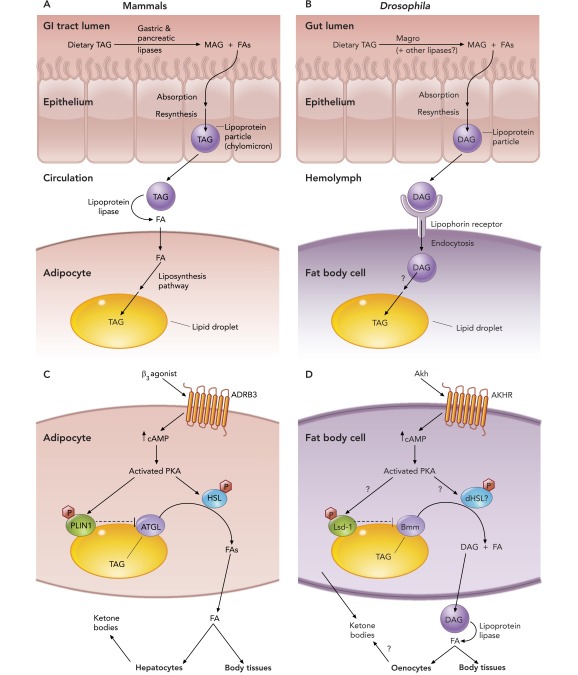FIGURE 1.
Lipid metabolism pathways in mammals and Drosophila
A and B: dietary fat digestion, transport, and storage. Dietary fats in the form of triglycerides (TAG) are broken down in the gut lumen by lipases to facilitate absorption into the epithelium, where the monoglyceride (MAG) and fatty acids (FAs) are used to reform TAG [or diglyceride (DAG) in flies] and packaged into lipoprotein particles. These particles are released into circulation and travel to the site of lipid storage (adipose tissue in mammals and fat body in flies) if the fats are not immediately required for energy production. In mammals, the TAG is broken down by lipoprotein lipase into glycerol and FAs that can then be taken up into the adipocytes and used to generate TAG, which is then stored in the intracellular lipid droplets. In flies, the lipoprotein particles are endocytosed by fat body cells via a lipophorin receptor-mediated mechanism, and the DAG is extracted and used to synthesize TAG, which is deposited into the lipid droplets by an unknown mechanism. C and D: lipid mobilization. In times when sugars are not readily available for energy production, a signal is sent to the lipid storage tissues to mobilize fats. β3-Agonists/adipokinetic hormone (Akh) bind to their respective G-protein-coupled receptors that activate PKA via adenyl cylase and increase in cAMP levels. In mammals, PKA phosphorylates perilipin 1 (PLIN1), relieving its inhibition of adipose triglyceride lipase (ATGL). PKA also phosphorylates hormone-sensitive lipase (HSL), thereby activating it, and, together with ATGL, the two proteins catalyze the breakdown of TAG from the lipid droplets to FAs. In Drosophila, PKA can phosphorylate the PLIN1 homolog lipid storage droplet-1 (Lsd-1), but whether this has functional significance is unknown. Flies also have a putative HSL homolog (CG11055), but its role in this process has not been elucidated. Akh receptor (AKHR) signaling stimulates the ATGL homolog Brummer (Bmm), which catalyzes the breakdown of lipid droplet TAG to DAG and FAs that are released into the circulation. In mammals, the FAs released from the adipocytes are taken up by the body tissues for energy production. Hepatocytes also use the FAs to produce ketone bodies that are used by the brain and muscle for energy production. In flies, the released DAG is taken up into lipoprotein particles and travels to the body tissues where it is further broken down to FAs by lipoprotein lipase. The fly fat body can also produce ketone bodies, but it is not known whether the hepatocyte-like oenocytes are also capable of ketogenesis. ADRB3, β3-adrenergic receptor.

